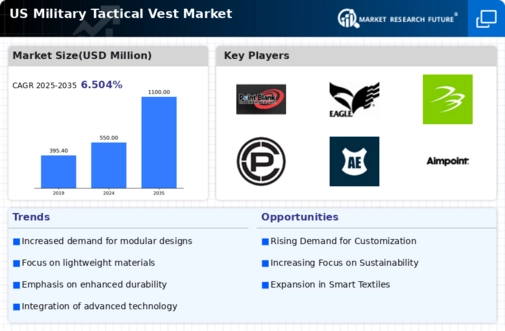Rising Defense Budgets
The military tactical-vest market is experiencing growth due to increasing defense budgets across various branches of the U.S. military. In recent years, the U.S. government has allocated substantial funds to enhance military capabilities, which includes investing in advanced personal protective equipment. For instance, the defense budget for 2025 is projected to exceed $800 billion, with a significant portion directed towards modernization and procurement of tactical gear. This financial commitment indicates a strong demand for high-quality tactical vests that meet the evolving needs of military personnel. As the military continues to prioritize soldier safety and operational efficiency, the military tactical-vest market is likely to benefit from this upward trend in defense spending.
Integration of Smart Technology
The tactical-vest market is evolving with the integration of smart technology into tactical gear. Innovations such as embedded sensors and communication systems are becoming increasingly prevalent, allowing for enhanced situational awareness and connectivity on the battlefield. The U.S. military is exploring these advancements to improve operational efficiency and soldier safety. As technology continues to advance, the demand for tactical vests equipped with smart features is expected to rise. This trend indicates a shift towards multifunctional gear that not only provides protection but also supports the operational capabilities of military personnel. The military tactical-vest market is likely to expand as manufacturers invest in developing smart tactical solutions.
Growing Demand for Customization
Customization is becoming a pivotal factor in the military tactical-vest market, as military units seek gear tailored to specific operational requirements. The need for specialized vests that accommodate various mission profiles is driving manufacturers to innovate and offer customizable options. This trend is particularly evident in the U.S. military, where units may require vests with unique configurations for different environments, such as urban warfare or combat in rugged terrains. The ability to modify vests with modular attachments and personal preferences enhances functionality and comfort, thereby increasing the appeal of tactical vests. As a result, the military tactical-vest market is likely to see a rise in demand for customizable solutions that cater to the diverse needs of military personnel.
Emphasis on Lightweight Materials
The military tactical-vest market is witnessing a shift towards the use of lightweight materials, which enhances mobility and comfort for soldiers. Recent advancements in fabric technology have led to the development of high-performance materials that provide adequate protection without adding excessive weight. This trend is particularly relevant in the U.S. military, where operational effectiveness is often contingent upon the agility of personnel. The integration of lightweight ballistic materials and breathable fabrics is becoming standard in tactical vest design. As the military continues to prioritize the physical demands placed on soldiers, the military tactical-vest market is expected to grow as manufacturers innovate to meet these requirements.
Increased Focus on Training and Simulation
The military tactical-vest market is influenced by an increased focus on training and simulation programs within the U.S. military. As training exercises become more realistic, the demand for tactical vests that can withstand rigorous use during simulations is rising. The military recognizes the importance of preparing personnel for real-world scenarios, which necessitates the use of durable and functional gear. Consequently, manufacturers are responding by producing vests that not only provide protection but also enhance the training experience. This emphasis on realistic training environments is likely to drive growth in the military tactical-vest market as military units seek reliable equipment that can endure the demands of extensive training.

















Leave a Comment